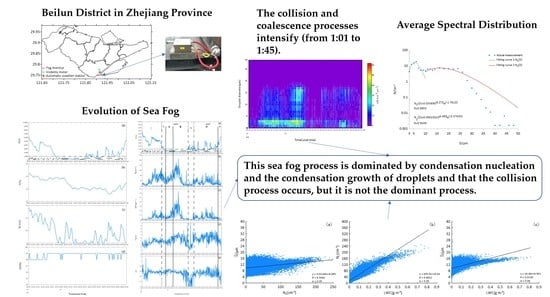Analysis of the Microphysical Structure and Evolution Characteristics of a Typical Sea Fog Weather Event in the Eastern Sea of China
Abstract
:1. Introduction
2. Data and Methods
2.1. Study Area
2.2. Data and Methods
3. Results and Analysis
3.1. Overview of the Sea Fog
3.2. Microphysical Features
3.2.1. Features of Each Stage
3.2.2. Features of the Droplet Spectrum
3.2.3. Features of Correlation and Difference
4. Discussion
5. Conclusions
- During the whole sea fog process, visibility has roughly the same change trend as temperature and wind speed, and it shows roughly an opposite change trend to microphysical quantities, such as number concentration and liquid water content.
- The change in the microphysical structure is mainly related to the microphysical process of fog, and the advection has little effect on the change in the microphysical structure. Temperature is closely related to nucleation, condensation growth, and other processes. The decrease (increase) in temperature is the main reason for the enhancement (weakening) of nucleation and the growth of condensation (evaporation of droplets), which leads to an increase (or decrease) in microphysical quantities, such as the droplet number concentration and liquid water content.
- The average droplet spectral distribution roughly conforms to the Gamma distribution, and the spectral distribution of the fog process presents a “multi-peak” structure, with peak diameters of 6 μm, 12 μm, 16 μm, 24 μm, and 44 μm. A large proportion of droplets have a diameter of less than 16 μm, accounting for 75%. Comparing the droplet spectrum distributions of sea fog between different regions, the droplet spectra in Zhanjiang and Maoming conform to the Junge distribution, and in the droplet spectra in the coastal areas of Zhoushan and southern Fujian conform to the Deirmenjian distribution. However, the spectral droplet distribution of the sea fog process in Zhanjiang from 20 to 21 March 2011 satisfies the Gamma distribution.
- During this sea fog process, three microphysical parameters, namely, number concentration, liquid water content, and average diameter, are all positively correlated in pairs, but the positive correlation between number concentration and average diameter is weak. This sea fog process is dominated by condensation nucleation and the condensation growth of droplets. The collision process mainly occurs in the development and maturation stage of the case1 process and the formation and development stages of the case2 process, and it is weak in other stages. The number concentration in the development and maturation stage of case1 increases rather than decreases, which may be due to the sufficient water vapor at this stage; the development of condensation nucleation and condensation growth is robust; collision and coalescence continue to occur; small particles aggregate into large particles; and the number of large particles increases. At the same time, condensation and nucleation ensure the stability of the number concentration of small particles.
Author Contributions
Funding
Data Availability Statement
Acknowledgments
Conflicts of Interest
References
- Gultepe, I.; Milbrandt, J.A. Microphysical observations and mesoscale model simulation of a warm fog case during FRAM project. In Fog and Boundary Layer Clouds: Fog Visibility and Forecasting; Birkhäuser: Basel, Switzerland, 2007; pp. 1161–1178. [Google Scholar]
- Zhang, S.; Ren, Z.; Liu, J.; Yang, Y.; Wang, X. Variations in the lower level of the PBL associated with the Yellow Sea fog-new observations by L-band radar. J. Ocean Univ. China 2008, 7, 353–361. [Google Scholar] [CrossRef]
- Lee, H.Y.; Chang, E.C. Impact of land-sea thermal contrast on the inland penetration of sea fog over the coastal area around the Korean Peninsula. J. Geophys. Res. Atmos. 2018, 123, 6487–6504. [Google Scholar] [CrossRef]
- The British Maritime Coast Guard Agency. Navigation in Restricted Visibility. Pilot NoticeMGN 369. 2008. Available online: https://assets.publishing.service.gov.uk/government/uploads/system/uploads/attachment_data/file/855852/MGN_369.pdf (accessed on 4 September 2022).
- Auckland Regional Council. Harbourmaster Periods of Restricted Visibility; Auckland Regional Council: Auckland, New Zealand, 2011. [Google Scholar]
- Bundes Ministerium for Verkehr Baus Office. Operation of Vessels during and Statent Wicklung. German Traffic Regulations for Navigable Maritime Waterways; Bundes Ministerium for Verkehr Baus Office: Berlin, Germany, 2012. [Google Scholar]
- Leigh, R.J. Economic benefits of terminal aerodrome forecasts (TAFs) for Sydney airport, Australia. Meteorol. Appl. 1995, 2, 239–247. [Google Scholar] [CrossRef]
- Pilié, R.J.; Mack, E.J.; Rogers, C.W.; Katz, U.; Kocmond, W.C. The formation of marine fog and the development of fog-stratus systems along the California coast. J. Appl. Meteorol. Climatol. 1979, 18, 1275–1286. [Google Scholar] [CrossRef]
- Findlater, J.; Roach, W.T.; McHugh, B.C. The haar of north-east Scotland. QJR Meteorol. Soc. 1989, 115, 581–608. [Google Scholar] [CrossRef]
- Gultepe, I.; Pearson, G.; Milbrandt, J.A.; Hansen, B.; Platnick, S.; Taylor, P.; Gordon, M.; Oakley, J.P.; Cober, S.G. The fog remote sensing and modeling field project. Bull. Am. Meteorol. Soc. 2009, 90, 341–360. [Google Scholar] [CrossRef]
- Isaac, G.A.; Bullock, T.; Beale, J.; Beale, S. Characterizing and predicting marine fog offshore Newfoundland and Labrador. Weather Forecast 2020, 35, 347–365. [Google Scholar] [CrossRef]
- Fernando, H.J.; Gultepe, I.; Dorman, C.; Pardyjak, E.; Wang, Q.; Hoch, S.W.; Richter, D.; Creegan, E.; Gaberšek, S.; Bullock, T.; et al. C-FOG: Life of coastal fog. Bull. Am. Meteorol. Soc. 2021, 102, 244–272. [Google Scholar] [CrossRef]
- Niu, S.; Lu, C.; Yu, H.; Zhao, L.; Lü, J. Fog research in China: An overview. Adv. Atmos. Sci. 2010, 27, 639–662. [Google Scholar] [CrossRef]
- Eldridge, R.G. The relationship between visibility and liquid water content in fog. J. Atmos. Sci. 1971, 28, 1183–1186. [Google Scholar] [CrossRef]
- Meyer, M.B.; Jiusto, J.E.; Lala, G.G. Measurements of visual range and radiation-fog (haze) microphysics. J. Atmos. Sci. 1980, 37, 622–629. [Google Scholar] [CrossRef]
- Kunkel, B.A. Parameterization of droplet terminal velocity and extinction coefficient in fog models. J. Appl. Meteorol. Climatol. 1984, 23, 34–41. [Google Scholar] [CrossRef]
- Goodman, J. The microstructure of California coastal fog and stratus. J. Appl. Meteorol. Climatol. 1977, 16, 1056–1067. [Google Scholar] [CrossRef]
- Bott, A.; Sievers, U.; Zdunkowski, W. A radiation fog model with a detailed treatment of the interaction between radiative transfer and fog microphysics. J. Atmos. Sci. 1990, 47, 2153–2166. [Google Scholar] [CrossRef]
- Zhao, L.; Niu, S.; Zhang, Y.; Xu, F. Microphysical characteristics of sea fog over the east coast of Leizhou Peninsula, China. Adv. Atmos. Sci. 2013, 30, 1154–1172. [Google Scholar] [CrossRef]
- Gultepe, I.; Tardif, R.; Michaelides, S.C.; Cermak, J.; Bott, A.; Bendix, J.; Müller, M.D.; Pagowski, M.; Hansen, B.; Ellrod, G.; et al. Fog research: A review of past achievements and future perspectives. Pure Appl. Geophys. 2007, 164, 1121–1159. [Google Scholar] [CrossRef]
- Liu, D.; Li, Z.; Yan, W.; Li, Y. Advances in fog microphysics research in China. Asia Pac. J. Atmos. Sci. 2017, 53, 131–148. [Google Scholar] [CrossRef]
- Gultepe, I.; Milbrandt, J.A.; Zhou, B. Marine fog: A review on microphysics and visibility prediction. In Marine Fog: Challenges and Advancements in Observations, Modeling, and Forecasting; Koracin, D., Dorman, C., Eds.; Springer: Berlin/Heidelberg, Germany, 2017; pp. 345–394. [Google Scholar]
- Zhang, Y.; Fan, S.X.; Zhang, S.T.; Wei, J.C. Microstructures and temporal variation characteristics during a sea fog event along the west coast of the Taiwan Strait. J. Trop. Meteorol. 2017, 23, 155–165. [Google Scholar]
- Li, Z.; Liu, D.; Yan, W.; Wang, H.; Zhu, C.; Zhu, Y.; Zu, F. Dense fog burst reinforcement over Eastern China: A review. Atmos. Res. 2019, 230, 104639. [Google Scholar] [CrossRef]
- Liu, D.; Yang, J.; Niu, S.; Li, Z. On the evolution and structure of a radiation fog event in Nanjing. Adv. Atmos. Sci. 2011, 28, 223–237. [Google Scholar] [CrossRef]
- Liu, Q.; Wu, B.; Wang, Z.; Hao, T. Fog droplet size distribution and the interaction between fog droplets and fine particles during dense fog in Tianjin, China. Atmosphere 2020, 11, 258. [Google Scholar] [CrossRef]
- Wang, S.; Yi, L.; Zhang, S.; Shi, X.; Chen, X. The microphysical properties of a sea-fog event along the west coast of the yellow sea in spring. Atmosphere 2020, 11, 413. [Google Scholar] [CrossRef] [Green Version]
- Liu, D.; Pu, M.; Yang, J.; Zhang, G.; Yan, W.; Li, Z. Microphysical structure and evolution of a four-day persistent fog event in Nanjing in December 2006. Acta Meteorol. Sin. 2010, 24, 104–115. [Google Scholar]
- Hsieh, W.C.; Jonsson, H.; Wang, L.P.; Buzorius, G.; Flagan, R.C.; Seinfeld, J.H.; Nenes, A. On the representation of droplet coalescence and autoconversion: Evaluation using ambient cloud droplet size distributions. J. Geophys. Res. Atmos. 2009, 114, D7. [Google Scholar] [CrossRef] [Green Version]
- Costa, A.A.; de Oliveira, C.J.; de Oliveira, J.C.P.; da Costa Sampaio, A.J. Microphysical observations of warm cumulus clouds in Ceara, Brazil. Atmos. Res. 2000, 54, 167–199. [Google Scholar] [CrossRef]
- Schmitt, C.G.; Stuefer, M.; Heymsfield, A.J.; Kim, C.K. The microphysical properties of ice fog measured in urban environments of Interior Alaska. J. Geophys. Res. Atmos. 2013, 118, 11–136. [Google Scholar] [CrossRef]
- Liu, Y. Skewness and kurtosis of measured raindrop size distributions. Atmos. Environ. 1992, 26, 2713–2716. [Google Scholar]
- Liu, Y. Statistical theory of the Marshall-Palmer distribution of raindrops. Atmos. Environ. 1993, 27, 15–19. [Google Scholar]
- Huang, H.; Huang, J.; Liu, C.; Yuan, J.; Lü, W.; Yang, Y.; Liao, F. Microphysical structural characteristics of sea fog in Maoming. Haiyang Xuebao 2009, 2, 17–23. (In Chinese) [Google Scholar]
- Zhang, S.; Niu, S.; Zhao, L. A case analysis of the microphysical structure of sea fog in the South China Sea. Chin. J. Atmos. Sci. 2013, 27, 552–562. (In Chinese) [Google Scholar]
- Yang, Z.; Xu, S.; Geng, P. Formation and microphysical structure of spring sea fog in Zhoushan area. Haiyang Xuebao 1989, 11, 431–438. (In Chinese) [Google Scholar]
- Zhang, W.; Chen, D.; Hu, Y.; Xun, A.; Jiang, Y.; Sun, X. Microphysical characteristics analysis of a spring sea fog process along the coast of southern Fujian. Meteor Mon. 2021, 47, 157–169. (In Chinese) [Google Scholar]
- Yue, Y.; Niu, S.; Zhao, L.; Zhang, Y.; Xu, F. Analysis of weather conditions and macro and micro characteristics of coastal fog in Zhanjiang area. Chin. J. Atmos. Sci. 2013, 27, 609–622. (In Chinese) [Google Scholar]
- Podzimek, J. Droplet concentration and size distribution in haze and fog. Studia Geophys. Geod. 1997, 41, 277–296. [Google Scholar] [CrossRef]
- Niu, S.; Lu, C.; Liu, Y.; Zhao, L.; Lü, J.; Yang, J. Analysis of the microphysical structure of heavy fog using a droplet spectrometer: A case study. Adv. Atmos. Sci. 2010, 27, 1259–1275. [Google Scholar] [CrossRef]
- Zhang, J.; Xue, H.; Deng, Z.; Ma, N.; Zhao, C.; Zhang, Q. A comparison of the parameterization schemes of fog visibility using the in-situ measurements in the North China Plain. Atmos. Environ. 2014, 92, 44–50. [Google Scholar] [CrossRef]
- Huang, H.; Huang, J.; Mao, W.; Liao, F.; Li, X.; Lü, W.; Yang, Y. Evolution characteristics of water content in sea fog and its relationship with atmospheric horizontal visibility in Maoming area. Haiyang Xuebao 2010, 32, 40–53. (In Chinese) [Google Scholar]
- Xu, F.; Han, L.; Lü, J.; Wang, J.; Tu, S.; Ji, Q.; Zhang, Y. Microphysical and chemical characteristics of a sea fog in the northwestern South China Sea. Chin. J. Trop. Meteorol. 2019, 35, 596–603. (In Chinese) [Google Scholar]
- Hu, L.; Yang, H.; Wang, H.; Ren, X. Joint Monitoring and Analysis of Sea Fog Using Dual Visibility Lidar in Ningbo, China. In Journal of Physics: Conference Series; IOP Publishing: Bristol, UK, 2021; Volume 2112, p. 012014. [Google Scholar]
- Hu, L.; Yang, H. Monitoring and analysis of sea fog in an offshore waterway using lidar. Opt. Eng. 2021, 60, 064103. [Google Scholar] [CrossRef]
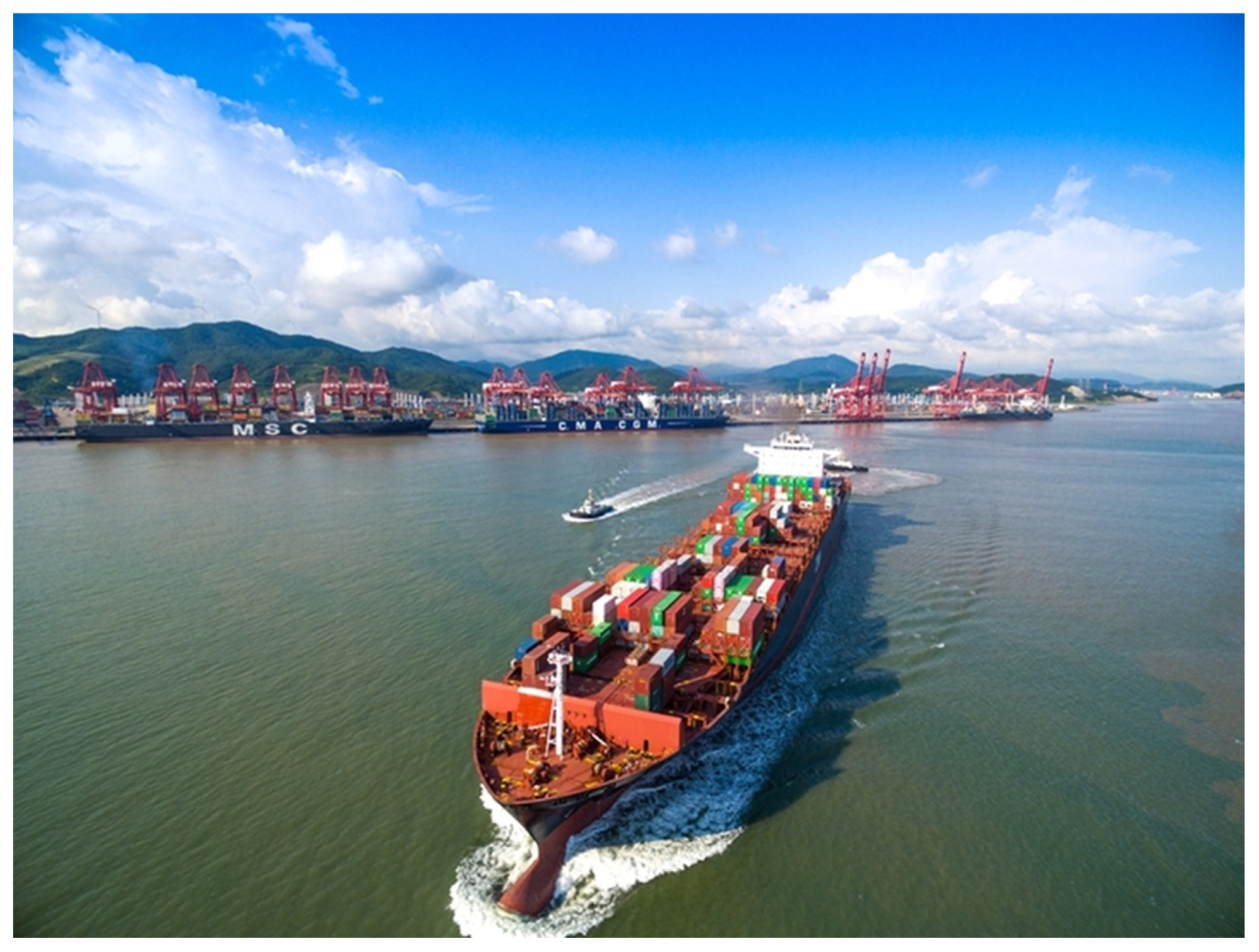


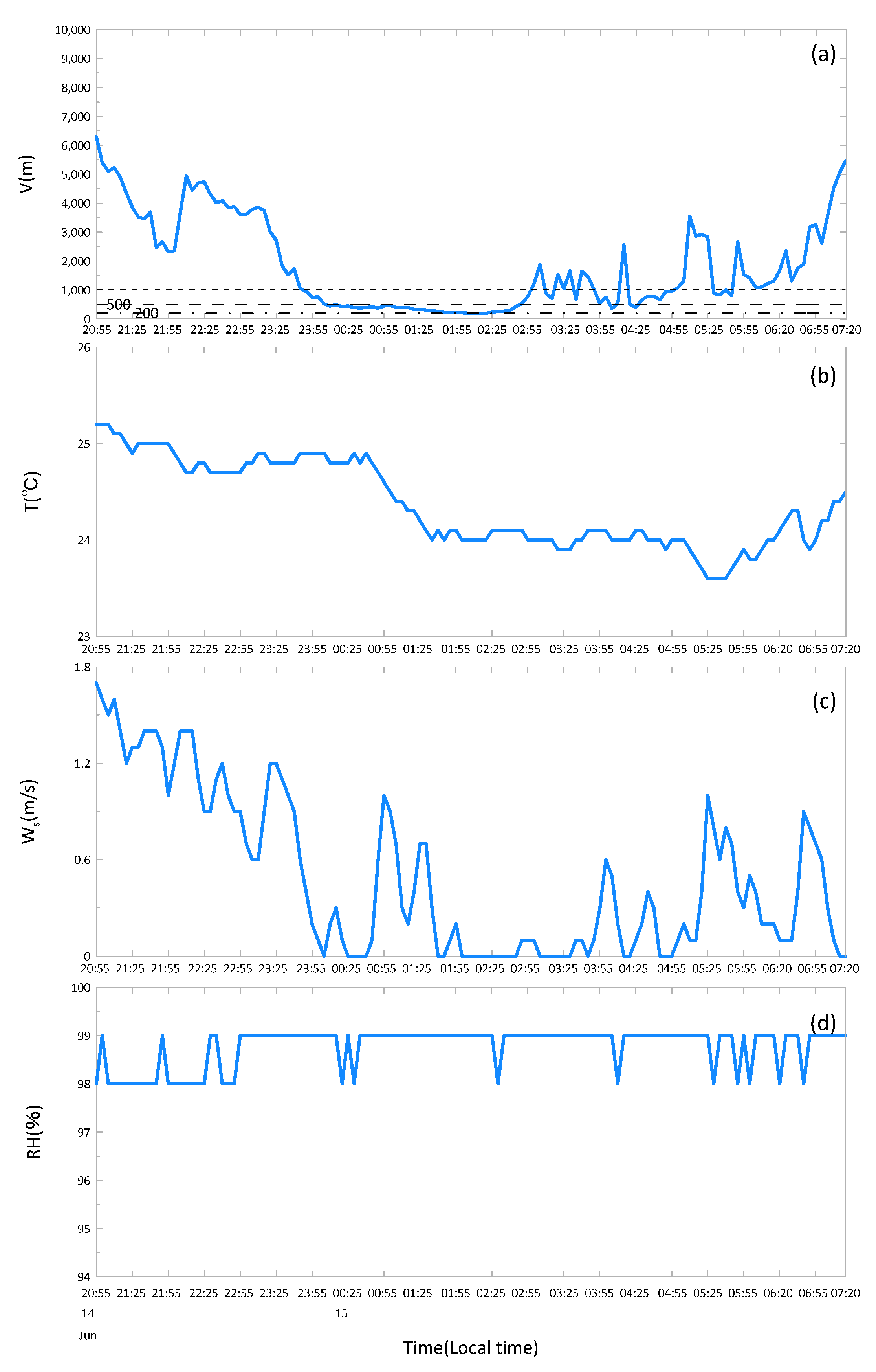
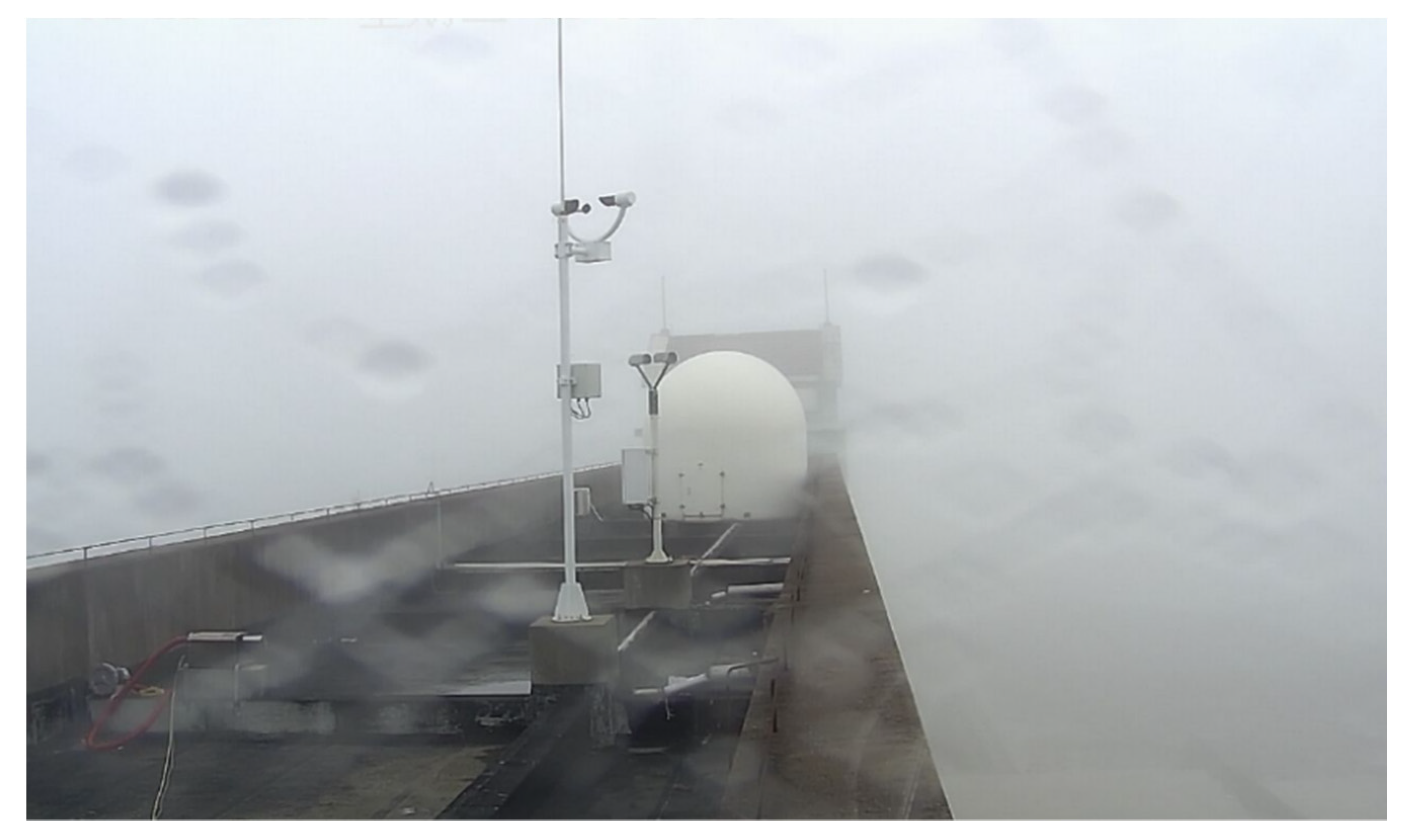
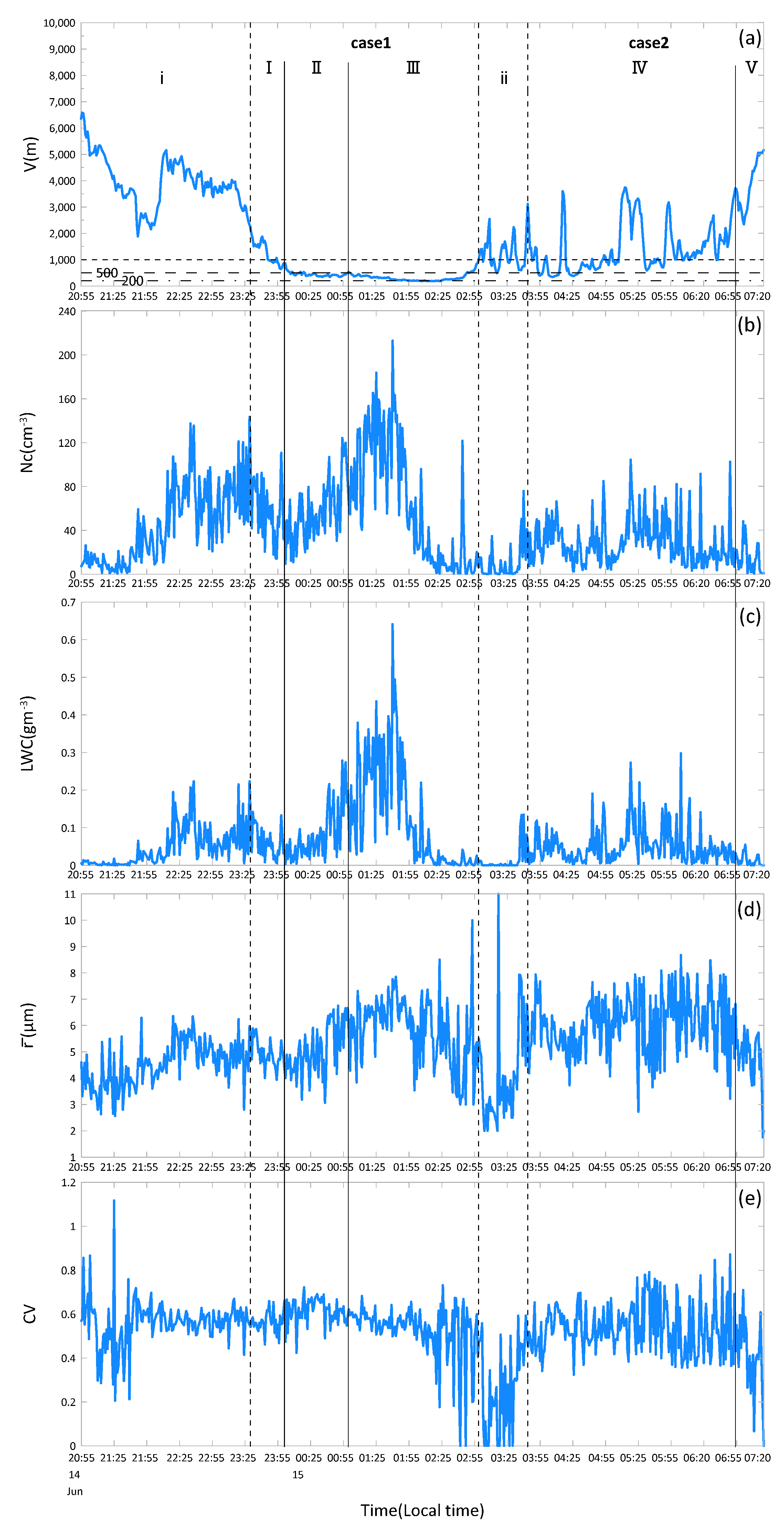
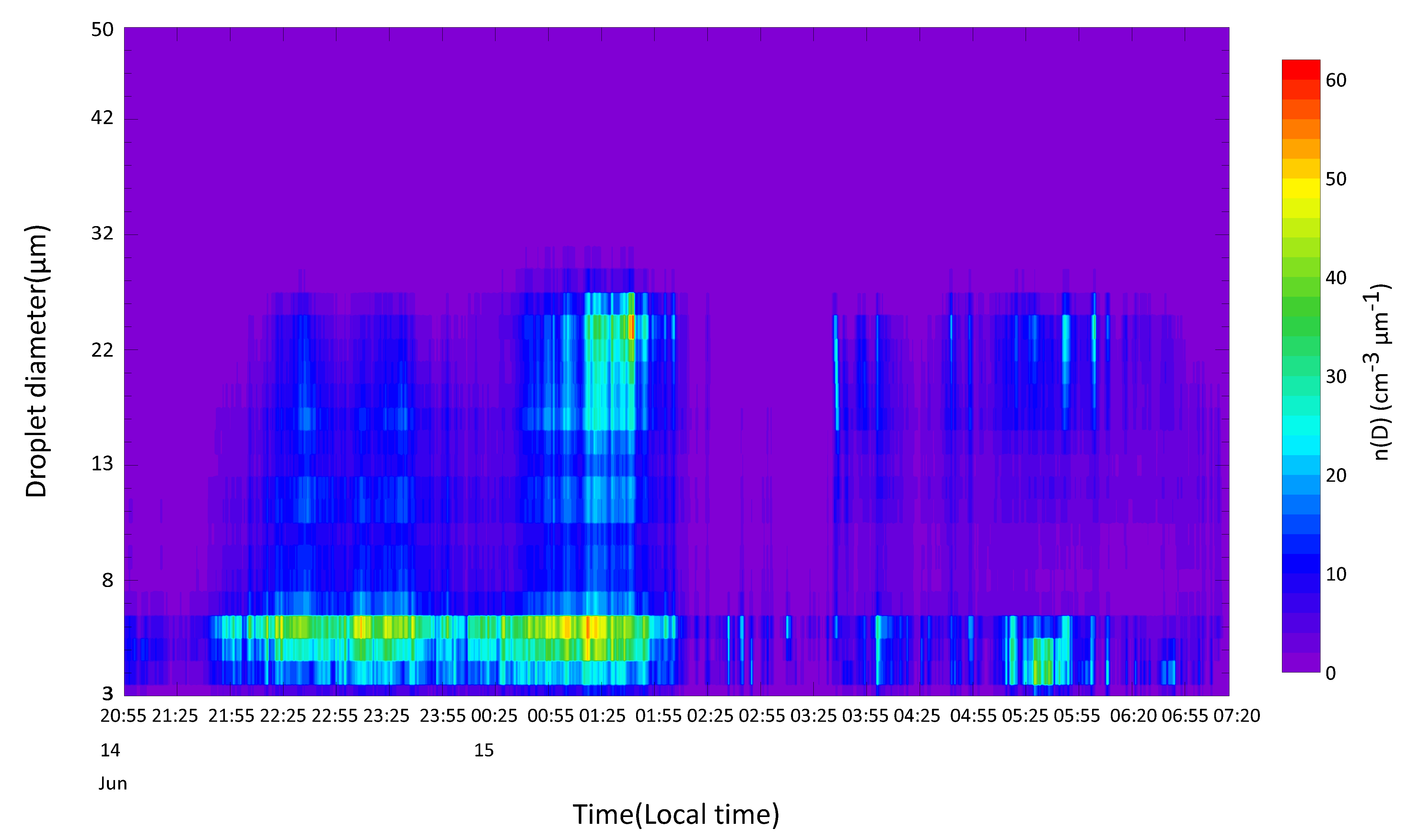
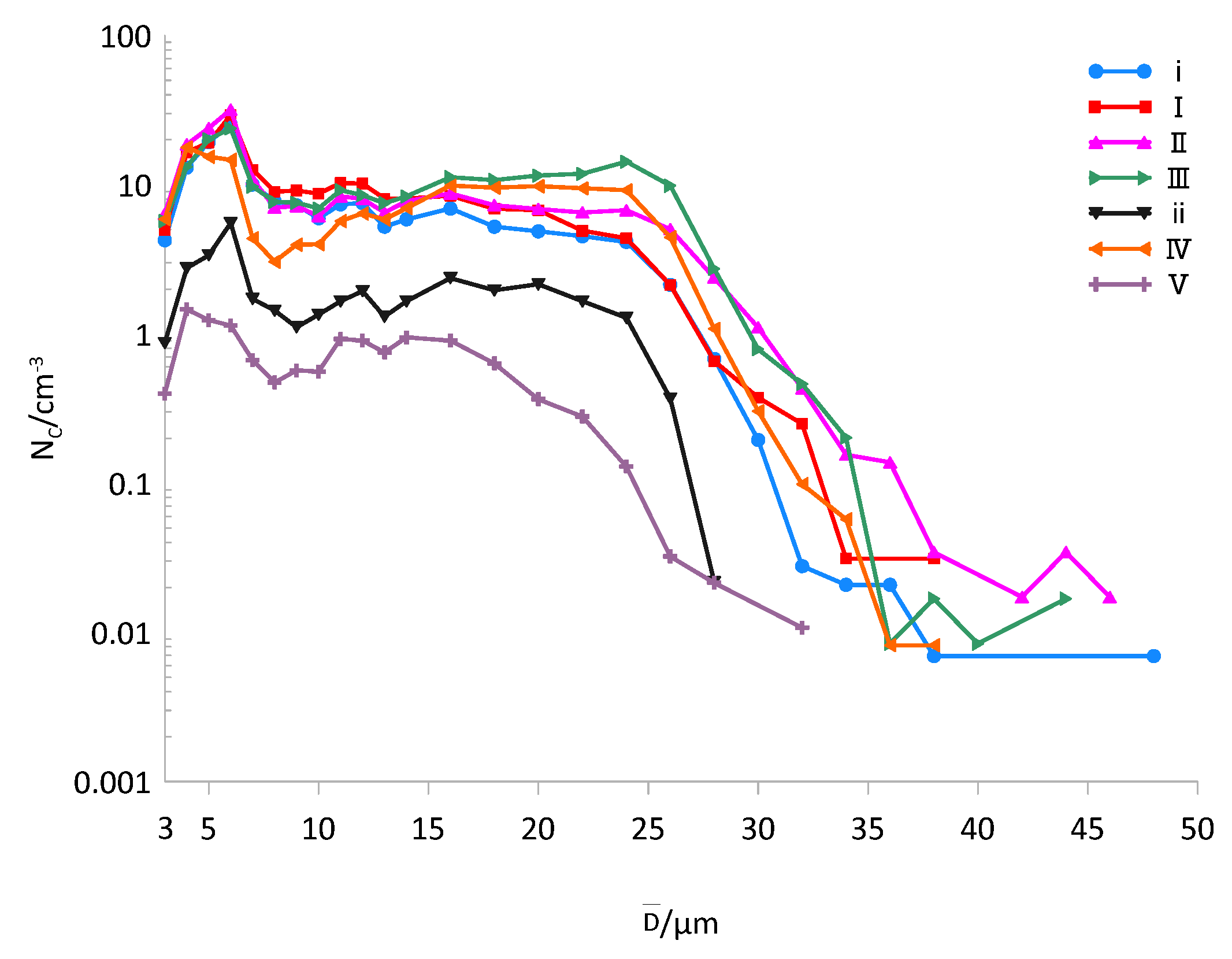
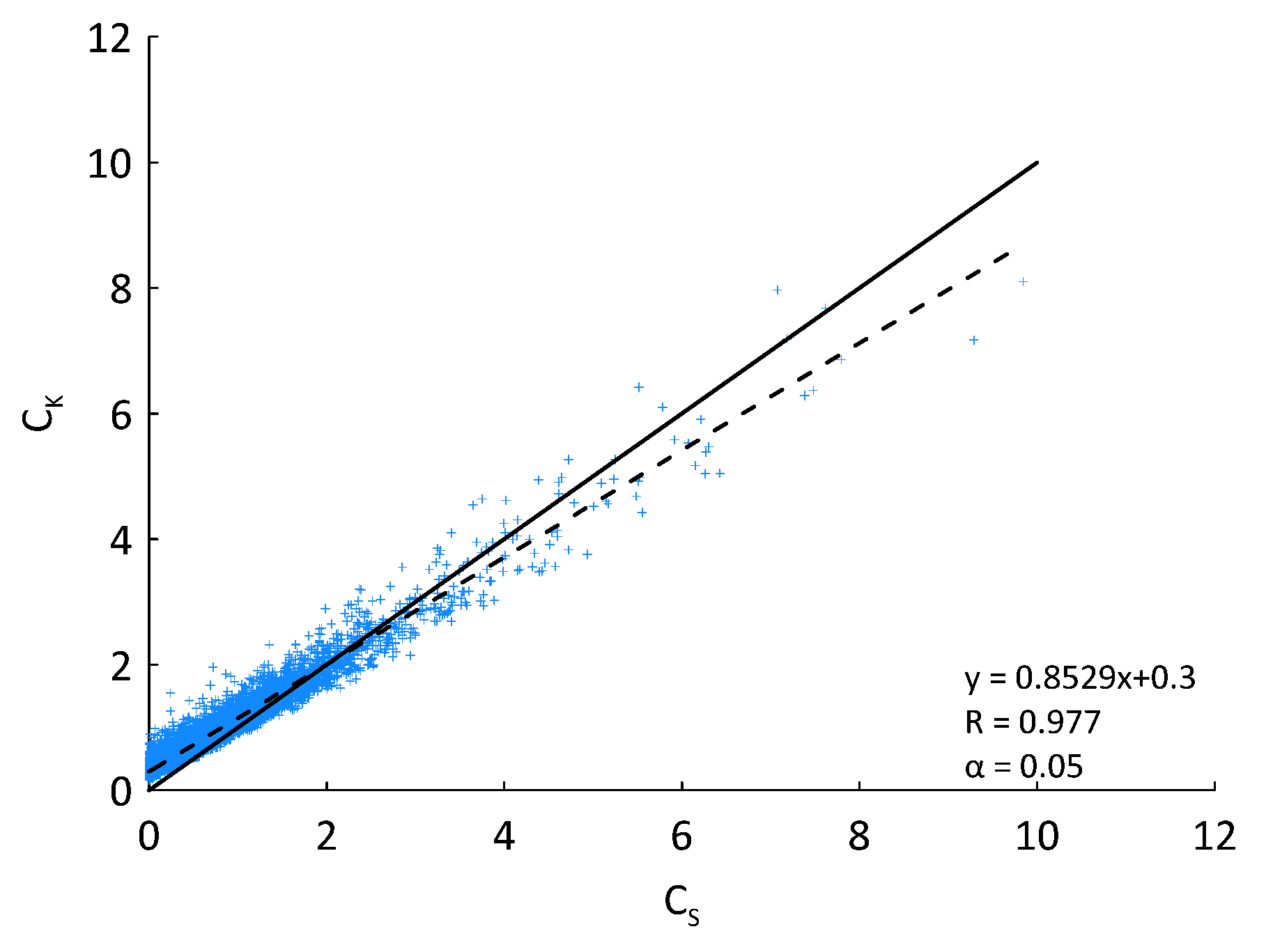
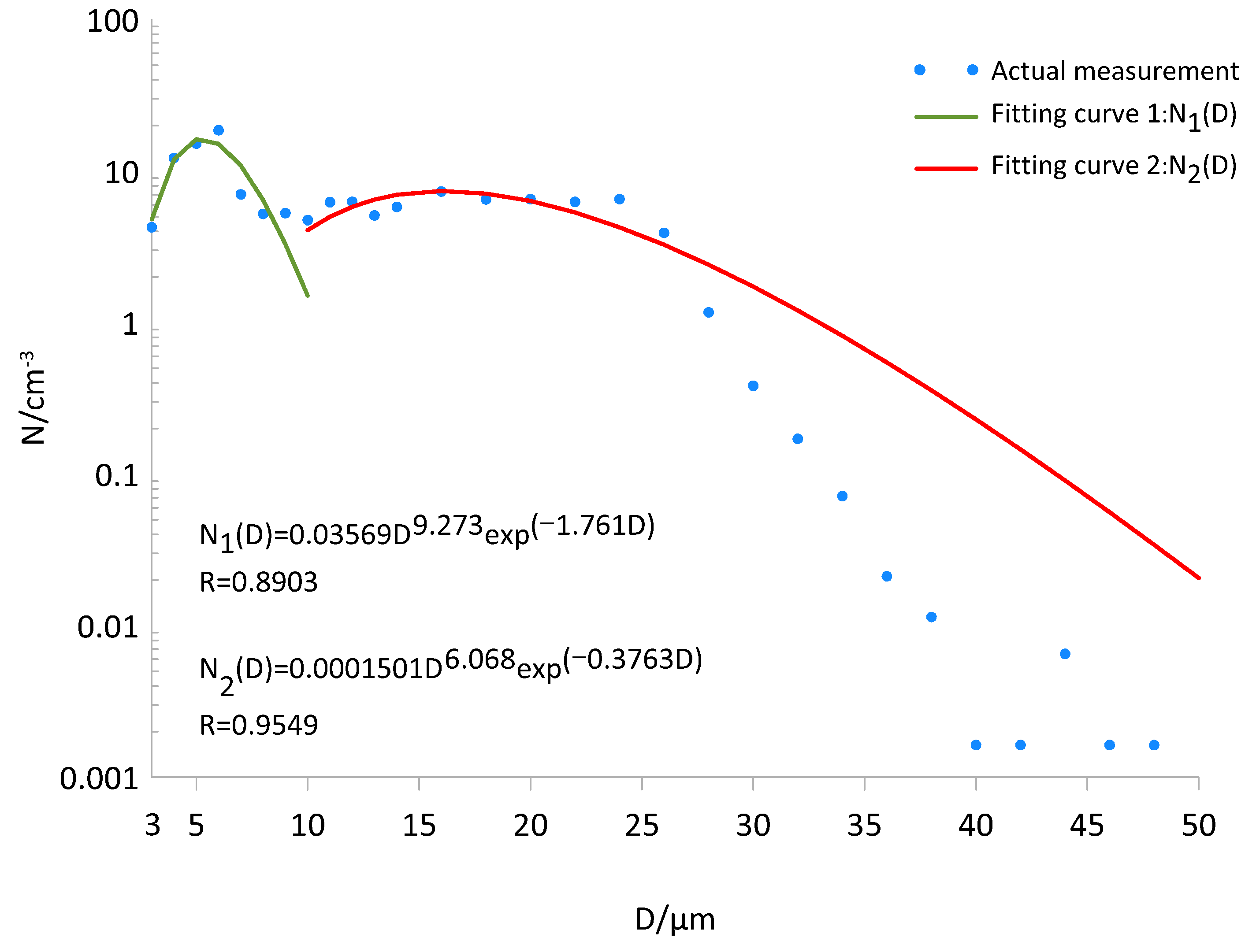


| Instrument | Manufacturer | Model | Time Resolution | Measured Parameters |
|---|---|---|---|---|
| Fog monitor | DMT, US | FM-120 | 1 s | LWC, NC, ED |
| Visibility meter | CAMA | CJY-1G | 1 min | V |
| Automatic weather station | Aerospace New Weather Technology Company | DZZ4 | 5 min | T, RH, WS |
| Physical Quantity | Formula |
|---|---|
| Number of droplets | |
| Average radius | |
| Variance | |
| Coefficient of Variation | |
| Gamma function | |
| K-order radius | |
| Skewness | |
| Kurtosis | |
| Skewness Deviation Coefficient | |
| Kurtosis deviation coefficient |
| Stage | Time | |
|---|---|---|
| i Gestation stage | 14 June 20:55–23:30 | |
| case1 | I Formation stage | 14 June 23:31–15 June 0:02 |
| II Development stage | 15 June 0:03–1:00 | |
| III Maturation and dissipation stage | 15 June 1:01–2:59 | |
| ii Intermittent stage | 15 June 3:00–3:45 | |
| case2 | IV Formation and development stage | 15 June 3:46–6:54 |
| V Dissipation stage | 15 June 6:55–7:20 | |
| NC/cm−3 | LWC/g m−3 | /μm | ||
|---|---|---|---|---|
| i Gestation stage | 45.4931 (0.6172–143.4675) | 0.0478 (1.4500 × 10−4–0.2237) | 4.5474 (2.5625–6.3610) | |
| case1 | I Formation stage | 55.7280 (9.5387–110.8600) | 0.0587 (0.0038–0.1422) | 4.8875 (3.9348–5.8897) |
| II Development stage | 57.9825 (11.0608–124.3664) | 0.0834 (0.0047–0.2786) | 5.0978 (3.0656–6.7576) | |
| III Maturation and dissipation stage | 62.1846 (0.3065–212.9253) | 0.1266 (2.6704 × 10−5–0.6410) | 5.8228 (3–10) | |
| ii Intermittent stage | 10.6179 (0.3075–75.9628) | 0.0137 (6.9055 × 10−6–0.1350) | 4.0662 (2–11) |
| Observation Location and Time | NC/cm−3 | LWC/g m−3 | /μm |
|---|---|---|---|
| Beilun, Zhejiang * 14–15 June 2021 | 41.5190 (0.3065–212.9253) | 0.0645 (6.9055 × 10−6–0.6410) | 5.3041 (1.7500–11) |
| East Island, Guangdong [38] ** 20–21 March 2011 | 231 (147–616) | 0.114 (0.001–0.594) | 3.3 (1.5–6.8) |
| Maoming, Guangdong [42] ** 16–17 March 2008 | 326.6 (15–422.6) | 0.058 (0.010–0.102) | 1.5 (1.2–2.45) |
| Northwest of the South China Sea [43] ** 10–11 March 2017 | 198 (42–445) | 0.116 (0.012–0.484) | 2.8 (1.9–6.4) |
| Qingdao, Shandong [27] * 5–8 April 2017 | 64.4 (1–146.9) | 0.057 (0.001–0.172) | 4.0 (1.9–6.7) |
| Zhoushan, Zhejiang [36] *** 19 May 1985 | 35.6 (/−122) | 0.13 (/−0.39) | 11.45 (/) |
Publisher’s Note: MDPI stays neutral with regard to jurisdictional claims in published maps and institutional affiliations. |
© 2022 by the authors. Licensee MDPI, Basel, Switzerland. This article is an open access article distributed under the terms and conditions of the Creative Commons Attribution (CC BY) license (https://creativecommons.org/licenses/by/4.0/).
Share and Cite
He, J.; Ren, X.; Wang, H.; Shi, Z.; Zhang, F.; Hu, L.; Zeng, Q.; Jin, X. Analysis of the Microphysical Structure and Evolution Characteristics of a Typical Sea Fog Weather Event in the Eastern Sea of China. Remote Sens. 2022, 14, 5604. https://doi.org/10.3390/rs14215604
He J, Ren X, Wang H, Shi Z, Zhang F, Hu L, Zeng Q, Jin X. Analysis of the Microphysical Structure and Evolution Characteristics of a Typical Sea Fog Weather Event in the Eastern Sea of China. Remote Sensing. 2022; 14(21):5604. https://doi.org/10.3390/rs14215604
Chicago/Turabian StyleHe, Jianxin, Xinyue Ren, Hao Wang, Zhao Shi, Fugui Zhang, Lijun Hu, Qiangyu Zeng, and Xin Jin. 2022. "Analysis of the Microphysical Structure and Evolution Characteristics of a Typical Sea Fog Weather Event in the Eastern Sea of China" Remote Sensing 14, no. 21: 5604. https://doi.org/10.3390/rs14215604
APA StyleHe, J., Ren, X., Wang, H., Shi, Z., Zhang, F., Hu, L., Zeng, Q., & Jin, X. (2022). Analysis of the Microphysical Structure and Evolution Characteristics of a Typical Sea Fog Weather Event in the Eastern Sea of China. Remote Sensing, 14(21), 5604. https://doi.org/10.3390/rs14215604









